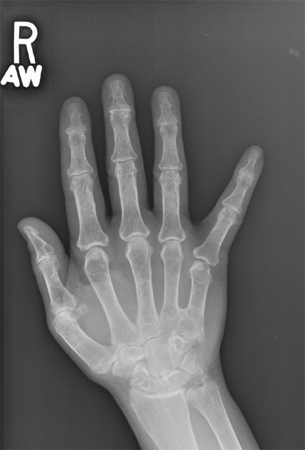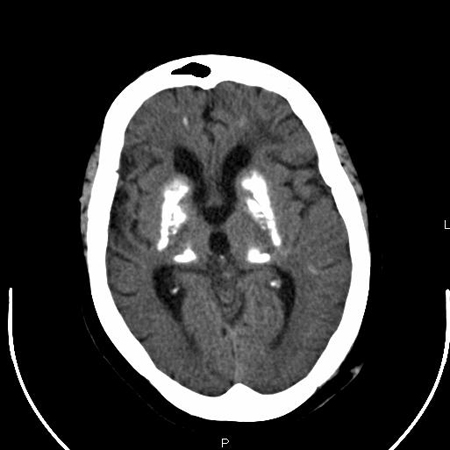Tests
1st tests to order
serum calcium
Test
Should be considered in patients with symptoms suggestive of hypocalcemia (seizures, paresthesia, muscle cramps, prolonged QT interval), in patients with a positive family history, and in those with Albright hereditary osteodystrophy.
Ideally should be performed fasting. Ionized calcium is the preferred test because it accounts for factors such as pH and protein binding.
If total calcium is used, an albumin level should be determined. Adjusted calcium level can be calculated when the albumin level is abnormal and gives an estimate of what the calcium level would be if the albumin level were within the normal range.
Adjusted calcium (mg/dL) = measured total Ca (mg/dL) + 0.8 x (4.0 - serum albumin [g/dL]), where 4.0 represents the average albumin level in g/dL.
Serum calcium is normal in pseudopseudohypoparathyroidism.
Result
typically low or may be normal
serum phosphorus
Test
Measured along with serum calcium.
Ideally should be performed fasted.
Serum phosphate is normal in pseudopseudohypoparathyroidism.
Result
typically elevated or may be normal
serum PTH
Test
Elevated PTH suggests pseudohypoparathyroidism (PHP).
Reduced PTH suggests hypoparathyroidism as the cause for hypocalcemia.
PTH levels can be normal in mild cases, and in pseudopseudohypoparathyroidism.
Result
typically elevated or may be normal
serum creatinine
Test
Necessary to interpret calcium and phosphorus values as appropriate or inappropriate. Secondary hyperparathyroidism due to chronic kidney disease should be suspected if hypocalcemia and hyperphosphatemia are associated with high PTH level and significant creatinine elevation.
Result
normal
serum magnesium
Test
A low level of magnesium needs to be corrected before interpreting PTH results.
Result
normal or low
serum 25-hydroxyvitamin D
Test
Usually normal in PHP.
Vitamin D deficiency can cause elevated PTH and hypocalcemia, and should be corrected before PHP is diagnosed.
Result
normal
follicle-stimulating hormone
Test
Evaluation of the gonadotropin axis, including follicle-stimulating hormone, should be considered in all patients with suspected type Ia and Ic PHP and in those who have symptoms of delayed puberty or infertility. Resistance to follicle-stimulating hormone may be present.
Result
may be elevated
luteinizing hormone
Test
Evaluation of the gonadotropin axis, including luteinizing hormone, should be considered in all patients with suspected type Ia and Ic PHP and in those who have symptoms of delayed puberty or infertility.
Result
may be elevated
estradiol
Test
Evaluation of the gonadotropin axis, including estradiol, should be considered in all patients with suspected type Ia and Ic PHP and in those who have symptoms of delayed puberty or infertility.
Result
may be low
testosterone
Test
Evaluation of the gonadotropin axis, including testosterone, should be considered in all patients with suspected type Ia and Ic PHP and in those who have symptoms of delayed puberty or infertility.
Result
may be low
growth hormone
Test
Evaluation of the growth hormone-releasing hormone-growth hormone axis should be considered in all patients with suspected type Ia and Ic PHP and in those who have symptoms of delayed puberty or infertility.
Result
growth hormone deficiency may be detected
insulin-like growth factor-1
Test
Evaluation of the growth hormone-releasing hormone-growth hormone axis, including insulin-like growth factor-1, should be considered in all patients with suspected types Ia and Ic PHP and in those who have symptoms of delayed puberty or infertility.
Result
may be low
Tests to consider
x-ray hands
Test
Brachydactyly in Albright hereditary osteodystrophy is produced by relative shortening and widening of specific long bones in the hands, usually the III, IV, and V metacarpals, and the first distal phalanx. [Figure caption and citation for the preceding image starts]: Hand radiograph suggestive of shortened IV and V metacarpalsFrom the collection of Kent Wehmeier, University of Florida Jacksonville [Citation ends].
Findings may be asymmetric.
Madelung-like wrist deformity (MLD) has been reported in patients with PHP type Ib. MLD is characterized by marked chondrodysostosis, prominence of the lower end of the ulna, marked shortening and bowing of the radius, and palmar and ulnar deviation of the carpal bones.[46]
Result
metacarpal shortening
ECG
Test
The QT interval is rate-dependent. A corrected QT (QTc) of more than 0.44 seconds is pathologic and requires further evaluation.
Required in any patient who is symptomatic or who has significant hypocalcemia to evaluate myocardial irritability
A prolonged QT interval can be an early sign of an impending arrhythmia.
Result
normal or increased QT interval
serum thyroid-stimulating hormone (TSH)
Test
Type Ia or Ic disease can have generalized hormone resistance; thyroid function tests (free thyroxine, TSH) should be performed early because thyroid dysfunction is the most common associated endocrine dysfunction seen in these patients.
Should be collected in the morning. Serum TSH levels exhibit a diurnal variation, with the peak occurring during the night and the nadir, which approximates to 50% of the peak value, occurring between 10 a.m. and 4 p.m. The effect of this biological variation on thyroid function tests will be minimized if TSH and thyroid hormone measurements are performed in the morning.
Result
normal or elevated
serum free thyroxine (T4)
Test
Type Ia or Ic disease can have generalized hormone resistance; thyroid function tests (free T4, TSH) should be performed early because thyroid dysfunction is the most common associated endocrine dysfunction seen in these patients.
Should be collected in the morning.
Result
normal or reduced
response to exogenous human PTH(1-34)
Test
Findings of this test help to confirm the diagnosis in cases with equivocal results in other tests, and to distinguish the different subtypes of PHP.[4]
Types Ia, Ib, and Ic produce a decreased response of cyclic adenosine monophosphate (cAMP) and phosphorus.
Type II produces a decreased phosphorus response but a normal cAMP response.
Pseudopseudohypoparathyroidism produces a normal phosphorus and normal cAMP response.
Result
decreased response of urinary phosphate and/or cAMP
dual-energy x-ray absorptiometry (DXA) bone-density scan
Test
Required in patients with fractures.
Bone loss can occur in any form of PHP due to preserved sensitivity of bone to PTH, but is usually only significant in patients with low sex steroid levels as a result of concomitant gonadotropin resistance.
Rarely, osteosclerosis has occurred (high bone density).[36]
Result
decreased bone mass; Z-score may be normal or below -2
CT head
Test
Not required for diagnosis. [Figure caption and citation for the preceding image starts]: CT findings of severe basal ganglia calcification in a patient with pseudohypoparathyroidismFrom the collection of Kent Wehmeier, University of Florida Jacksonville [Citation ends].
Usually performed to exclude other causes of seizures or confusion.
Result
basal ganglia calcifications
mutation analysis of GNAS
Test
Identifies mutations in GNAS (the gene that codes for the guanine nucleotide-binding protein Gs-alpha) that cause types Ia, Ib, and pseudopseudohypoparathyroidism.
If there are existing genetic test results, do not perform repeat testing unless there is uncertainty about the existing result, e.g., the result is inconsistent with the patient’s clinical presentation or the test methodology has changed.[44]
Result
may or may not identify mutation
Use of this content is subject to our disclaimer